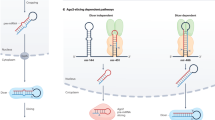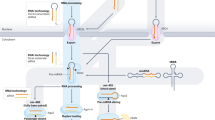Abstract
The capacity of highly parallel sequencing technologies to detect small RNAs at unprecedented depth suggests their value in systematically identifying microRNAs (miRNAs). However, the identification of miRNAs from the large pool of sequenced transcripts from a single deep sequencing run remains a major challenge. Here, we present an algorithm, miRDeep, which uses a probabilistic model of miRNA biogenesis to score compatibility of the position and frequency of sequenced RNA with the secondary structure of the miRNA precursor. We demonstrate its accuracy and robustness using published Caenorhabditis elegans data and data we generated by deep sequencing human and dog RNAs. miRDeep reports altogether ∼230 previously unannotated miRNAs, of which four novel C. elegans miRNAs are validated by northern blot analysis.
This is a preview of subscription content, access via your institution
Access options
Subscribe to this journal
Receive 12 print issues and online access
$209.00 per year
only $17.42 per issue
Buy this article
- Purchase on SpringerLink
- Instant access to full article PDF
Prices may be subject to local taxes which are calculated during checkout





Similar content being viewed by others
References
Bushati, N. & Cohen, S.M. microRNA Functions. Annu. Rev. Cell Dev. Biol. 23, 175–205 (2007).
Bartel, D.P. MicroRNAs: genomics, biogenesis, mechanism, and function. Cell 116, 281–297 (2004).
Miranda, K.C. et al. A pattern-based method for the identification of MicroRNA binding sites and their corresponding heteroduplexes. Cell 126, 1203–1217 (2006).
Aravin, A. & Tuschl, T. Identification and characterization of small RNAs involved in RNA silencing. FEBS Lett. 579, 5830–5840 (2005).
Landgraf, P. et al. A mammalian microRNA expression atlas based on small RNA library sequencing. Cell 129, 1401–1414 (2007).
Bentwich, I. Prediction and validation of microRNAs and their targets. FEBS Lett. 579, 5904–5910 (2005).
Lau, N.C. et al. Characterization of the piRNA complex from rat testes. Science 313, 363–367 (2006).
Ruby, J.G. et al. Large-scale sequencing reveals 21U-RNAs and additional microRNAs and endogenous siRNAs in C. elegans. Cell 127, 1193–1207 (2006).
Berezikov, E. et al. Diversity of microRNAs in human and chimpanzee brain. Nat. Genet. 38, 1375–1377 (2006).
Aravin, A.A., Sachidanandam, R., Girard, A., Fejes-Toth, K. & Hannon, G.J. Developmentally regulated piRNA clusters implicate MILI in transposon control. Science 316, 744–747 (2007).
Girard, A., Sachidanandam, R., Hannon, G.J. & Carmell, M.A. A germline-specific class of small RNAs binds mammalian Piwi proteins. Nature 442, 199–202 (2006).
Pak, J. & Fire, A. Distinct populations of primary and secondary effectors during RNAi in C. elegans. Science 315, 241–244 (2007).
Brennecke, J. et al. Discrete small RNA-generating loci as master regulators of transposon activity in Drosophila. Cell 128, 1089–1103 (2007).
Houwing, S. et al. A role for Piwi and piRNAs in germ cell maintenance and transposon silencing in Zebrafish. Cell 129, 69–82 (2007).
Tarasov, V. et al. Differential regulation of microRNAs by p53 revealed by massively parallel sequencing: miR-34a is a p53 target that induces apoptosis and G1-arrest. Cell Cycle 6, 1586–1593 (2007).
Chen, K. & Rajewsky, N. The evolution of gene regulation by transcription factors and microRNAs. Nat. Rev. Genet. 8, 93–103 (2007).
Grishok, A. et al. Genes and mechanisms related to RNA interference regulate expression of the small temporal RNAs that control C. elegans developmental timing. Cell 106, 23–34 (2001).
Hutvagner, G. et al. A cellular function for the RNA-interference enzyme Dicer in the maturation of the let-7 small temporal RNA. Science 293, 834–838 (2001).
Filipowicz, W., Bhattacharyya, S.N. & Sonenberg, N. Mechanisms of post-transcriptional regulation by microRNAs: are the answers in sight? Nat. Rev. Genet. 9, 102–114 (2008).
Rajewsky, N. microRNA target predictions in animals. Nat. Genet. 38 Suppl, S8–S13 (2006).
Bonnet, E., Wuyts, J., Rouze, P. & Van de Peer, Y. Evidence that microRNA precursors, unlike other non-coding RNAs, have lower folding free energies than random sequences. Bioinformatics 20, 2911–2917 (2004).
Pasquinelli, A.E. et al. Conservation of the sequence and temporal expression of let-7 heterochronic regulatory RNA. Nature 408, 86–89 (2000).
Chen, K. & Rajewsky, N. Deep conservation of microRNA-target relationships and 3′UTR motifs in vertebrates, flies, and nematodes. Cold Spring Harb. Symp. Quant. Biol. 71, 149–156 (2006).
Griffiths-Jones, S., Grocock, R.J., van Dongen, S., Bateman, A. & Enright, A.J. miRBase: microRNA sequences, targets and gene nomenclature. Nucleic Acids Res. 34, D140–D144 (2006).
Berezikov, E. et al. Many novel mammalian microRNA candidates identified by extensive cloning and RAKE analysis. Genome Res. 16, 1289–1298 (2006).
Vagin, V.V. et al. A distinct small RNA pathway silences selfish genetic elements in the germline. Science 313, 320–324 (2006).
Wightman, B., Ha, I. & Ruvkun, G. Posttranscriptional regulation of the heterochronic gene lin-14 by lin-4 mediates temporal pattern formation in C. elegans. Cell, 75, 855–862 (1993).
Lee, R.C., Feinbaum, R.L. & Ambros, V. The C. elegans heterochronic gene lin-4 encodes small RNAs with antisense complementarity to lin-14. Cell 75, 843–854 (1993).
Ambros, V., Lee, R.C., Lavanway, A., Williams, P.T. & Jewell, D. MicroRNAs and other tiny endogenous RNAs in C. elegans. Curr. Biol. 13, 807–818 (2003).
Ohler, U., Yekta, S., Lim, L.P., Bartel, D.P. & Burge, C.B. Patterns of flanking sequence conservation and a characteristic upstream motif for microRNA gene identification. RNA 10, 1309–1322 (2004).
Berezikov, E. et al. Phylogenetic shadowing and computational identification of human microRNA genes. Cell 120, 21–24 (2005).
Lindblad-Toh, K. et al. Genome sequence, comparative analysis and haplotype structure of the domestic dog. Nature 438, 803–819 (2005).
Hofacker, I.L. Vienna RNA secondary structure server. Nucleic Acids Res. 31, 3429–3431 (2003).
Altschul, S.F., Gish, W., Miller, W., Myers, E.W. & Lipman, D.J. Basic local alignment search tool. J. Mol. Biol. 215, 403–410 (1990).
Palakodeti, D., Smielewska, M. & Graveley, B.R. MicroRNAs from the Planarian Schmidtea mediterranea: a model system for stem cell biology. RNA 12, 1640–1649 (2006).
Rettig, M.P. et al. Evaluation of biochemical changes during in vivo erythrocyte senescence in the dog. Blood 93, 376–384 (1999).
Chomczynski, P. & Sacchi, N. Single-step method of RNA isolation by acid guanidinium thiocyanate-phenol-chloroform extraction. Anal. Biochem. 162, 156–159 (1987).
Lagos-Quintana, M., Rauhut, R., Lendeckel, W. & Tuschl, T. Identification of novel genes coding for small expressed RNAs. Science 294, 853–858 (2001).
Karolchik, D. et al. The UCSC Genome Browser Database. Nucleic Acids Res. 31, 51–54 (2003).
Griffiths-Jones, S. et al. Rfam: annotating non-coding RNAs in complete genomes. Nucleic Acids Res. 33, D121–D124 (2005).
Altschul, S.F., Bundschuh, R., Olsen, R. & Hwa, T. The estimation of statistical parameters for local alignment score distributions. Nucleic Acids Res. 29, 351–361 (2001).
Acknowledgements
We thank H.-H. Ropers for making possible the deep sequencing of HeLa cell and the dog lymphocyte RNA at the Max Planck Institute for Molecular Genetics in Berlin. We are indebted to Alejandro Sánchez Alvarado and John Kim for the planarian data. Thomas Isenbarger helped at the very initial stage of the project. Eugene Berezikov kindly provided unpublished deep-sequencing data (not used in this study). Ralf Bundschuh helped with parameter estimations. M.R.F. acknowledges a fellowship from the Max Delbrück Center. J.M. acknowledges a fellowship from Deutsche Forschungsgemeinschaft (International Research Training Group 1360). Finally, many thanks to the members of the Rajewsky lab for countless hours of stimulating discussions, and in particular to Nadine Thierfelder and Svetlana Lebedeva for providing the HeLa cell and C. elegans samples.
Author information
Authors and Affiliations
Corresponding author
Supplementary information
Supplementary Text and Figures
Supplementary Figures 1–2, Sequences (PDF 1121 kb)
Supplementary Table 1
Excel file (XLS 47 kb)
Rights and permissions
About this article
Cite this article
Friedländer, M., Chen, W., Adamidi, C. et al. Discovering microRNAs from deep sequencing data using miRDeep. Nat Biotechnol 26, 407–415 (2008). https://doi.org/10.1038/nbt1394
Issue Date:
DOI: https://doi.org/10.1038/nbt1394
This article is cited by
-
Tissue-specific profiling of age-dependent miRNAomic changes in Caenorhabditis elegans
Nature Communications (2024)
-
Identification of novel microRNAs in the embryonic mouse brain using deep sequencing
Molecular and Cellular Biochemistry (2024)
-
Discovery of circulating miRNAs as biomarkers of chronic Chagas heart disease via a small RNA-Seq approach
Scientific Reports (2024)
-
Resequencing of the TMF-1 (TATA Element Modulatory Factor) regulated protein (TRNP1) gene in domestic and wild canids
Canine Medicine and Genetics (2023)
-
MiR-196b-3p and miR-450b-3p are key regulators of adipogenesis in porcine intramuscular and subcutaneous adipocytes
BMC Genomics (2023)



